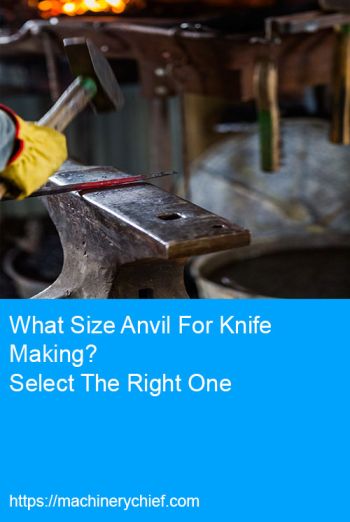Anvils represent the craftsmanship journey from dark days up to date. These tools are still useful in various metal workings, like making knives and jewelry. There exist different types of anvils with varying sizes for other blacksmithing applications. To determine the extent of anvil you require, you should first understand the size of your hammer and the type of the tasks you will be handling.
Be it an amateur or a professional blacksmith; you need to have the right size anvil for every type of blacksmithing job. Therefore, this “What Size Anvil For Knife Making article” should help you with coherent information to help you get the right size anvil for your job.
Size of anvils for knife making
Different anvils have different sized-working surfaces and shapes for specific blacksmithing tasks. There are five different types of anvils with varying sizes for various blacksmithing applications, i.e., farrier’s, forging, shoeing, jewelers, sheet metal, and bench anvils.

However, you can use some of these tools in more than one application; they have multiple tasks. For example, a forging anvil, you can use it in both light forging and horseshoes. Sheet metal is also another type that can be useful even in both bench work and light forging.

Benchwork small anvil is suitable for jewelry tasks. The most important thing to understand is that the right size anvil results in more significant end products and makes work easier. The size of your anvil must be massive or lighter, depending on the size of the hammer you are using to perform your job. For example, a hammer of 4 1800 grams matches with a 90kg anvil for knife making.
Many people prefer 100 to 150 pounds anvil because of their large and convenient size. For knife making, 75 to 125 pounds can still work better for you. Some smiths also prefer the narrow surface of smaller anvils, especially specialists in knife making, sculpture, and architectural work; 200 pounds is enough for such cases.
Smiths who handle heavy jobs also need a heavy anvil of not less than 200 pounds. These tools come with different features that also matters a lot while determining the size of the anvil for making knives. More so, their style also plays a vital role in differentiating sizes. Some of the other features that you may use to determine the extent of anvil include; horns, face, hardy hole, pritchel, or punching hole; these are common characteristics that exist among them.
However, the size of the rectangular or square heel and many punching holes can also be actual size determining factors. For example, a small stake anvil becomes useful in knife making and other light blacksmithing tasks. You may support it in a bench socket or the stake plate. More so, you can keep it in a vice if you are handling light tasks.
On the other hand, bench anvils have sizes ranging from 5 pounds to 50 pounds and are mainly useful for bench works. They are primarily for supporting your work while hammering, and most of them are full of steel. These anvils are versatile in that apart from knife making, and you can also use them to handle other blacksmithing works.
Another type of anvils that you can use in making knives is the jeweler’s anvils; they come with an old-fashioned style with a suitable size for knife making. These tools also feature extended slender beaks and a square body.
More so, some of these jewelers anvils come with different designs like stakes that allow you to mount them on a bench. They are strong enough to withstand hammer hits when making your knives.
Frequently asked questions regarding What Size Anvil For Knife Making
What size of the anvil can I use for blacksmithing?
The size of the anvil you need depends on your sector. Therefore, a standard size for blacksmithing should be more than 70 pounds.
What is the significance of anvil’s shapes?
Anvils have different shapes to enable you to shape metals in various ways.
Conclusion
After going through the above report, you can agree that the right anvil size guarantees better results. Always make sure that the surface of your anvil has enough space for hammering. It is advisable to have a more massive anvil’s character than that of the hammer.


